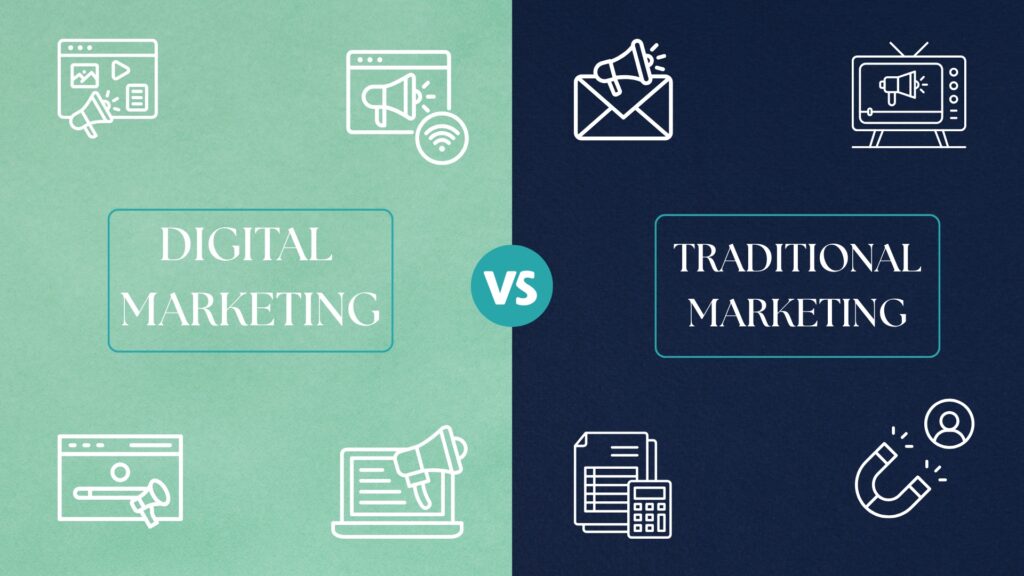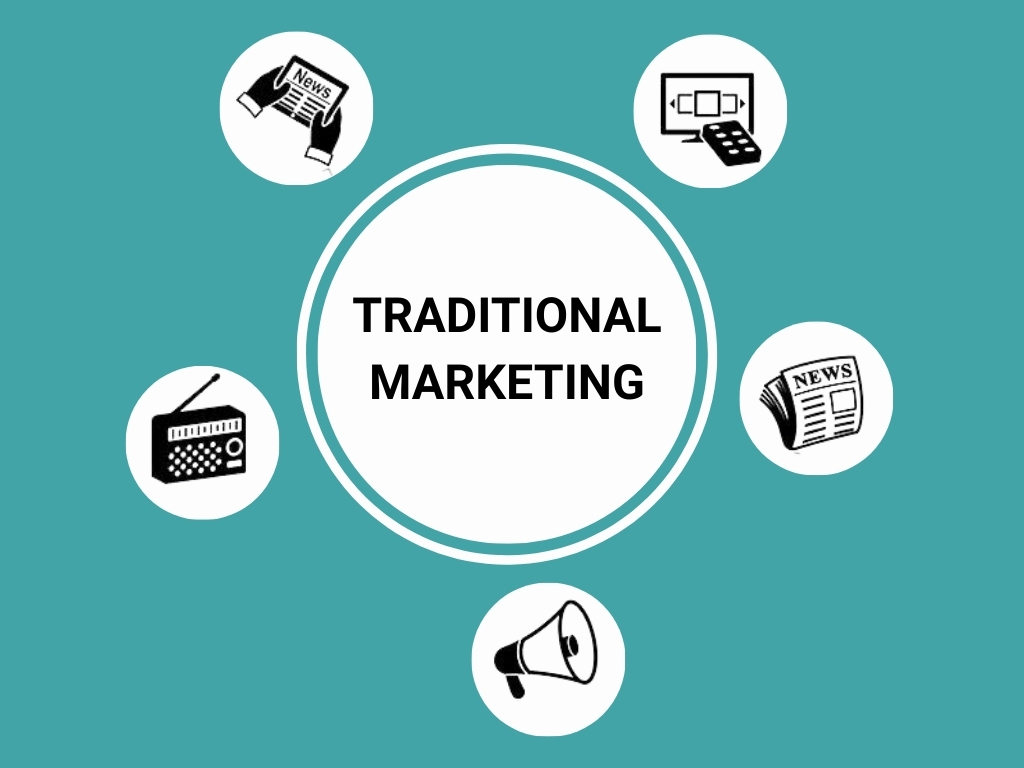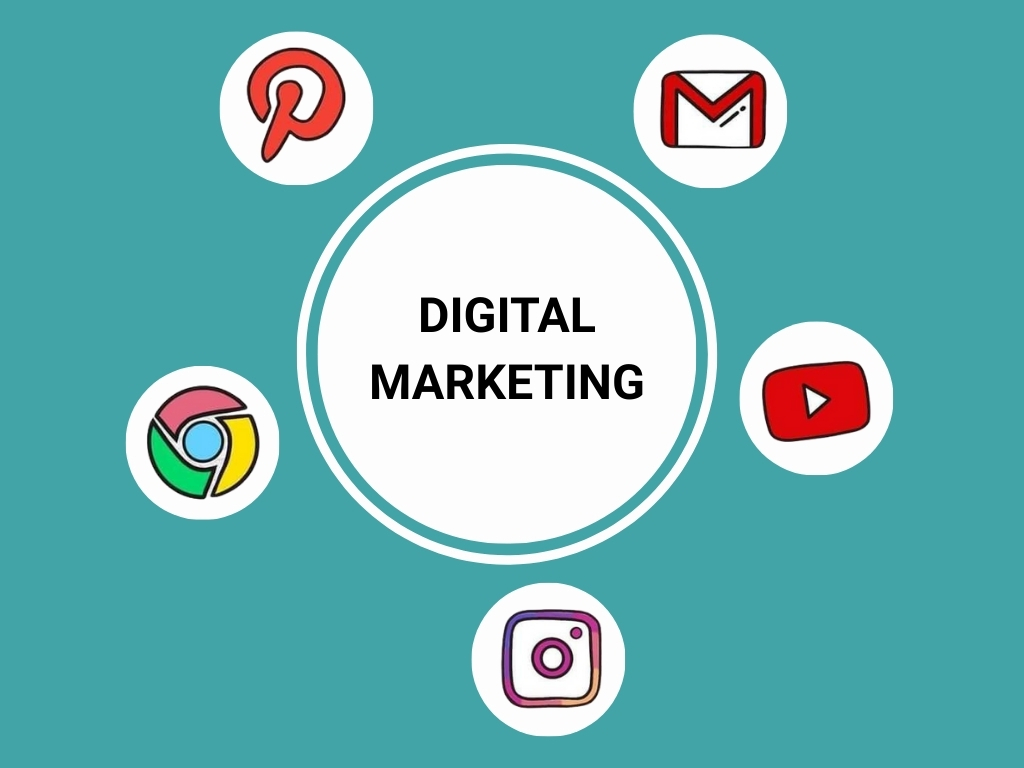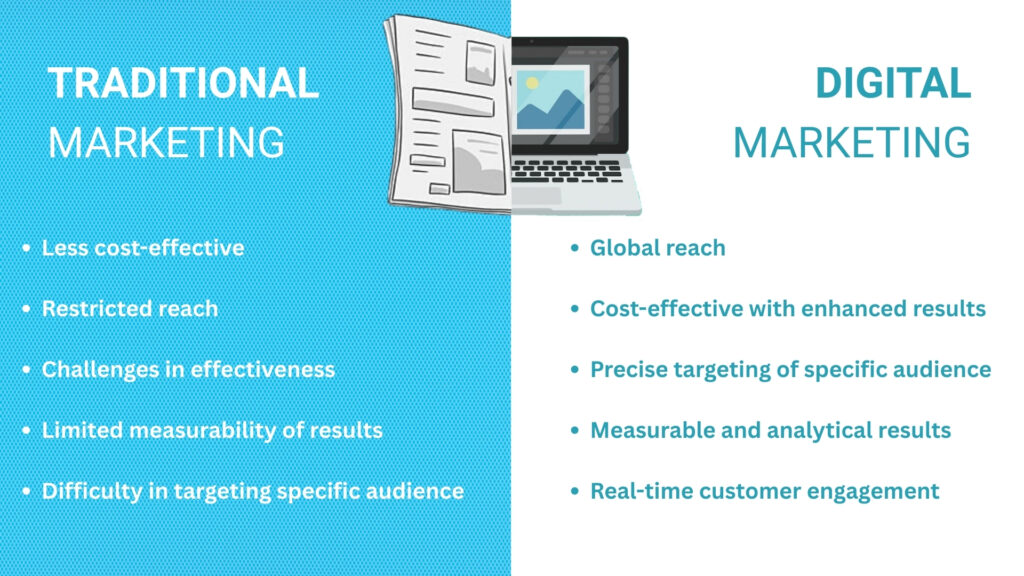
Traditional Marketing vs Digital Marketing
Marketing is promoting, selling, and distributing products or services to customers. It is the process of grasping what individuals want or need, making those products to fulfill these needs, and then presenting their value so as to persuade customers to purchase them. Way back when, humans used TV advertisements, newspapers, billboards, and brochures. That is called Traditional Marketing. Currently, because everyone owns phones, computers, and the internet, humans are using Digital Marketing. So what is best? Traditional Marketing or Digital Marketing? Let us learn both!
What is Traditional Marketing?

When we talk of conventional marketing, we are talking of promoting something through means we can see everywhere, such as billboards, posters, and other traditional ways of advertising.
Here, in this type of marketing, the companies try to reach out to people through media like newspapers, magazines, billboards, television, radio, posters, or through direct person-to-person interaction. Conventional marketing matters since it is able to reach individuals who lack access to internet.
For instance, most elderly people still have trust in newspapers and view TV every day. If a company advertises in the newspaper or on TV, such individuals are likely to see it.
What is Digital Marketing?

Digital marketing refers to marketing product or service using the internet. It uses digital platforms such as social media, Google, sites, or email to reach customers.
The type of marketing is becoming increasingly popular because most people today spend a lot of time on computers and mobile phones. It is easy for companies to target such people by displaying advertisements on their mobile phones and computers.
One of the best things about digital marketing is that it is cheap. Even a small business can create a Facebook or Instagram ad with little budget and reach thousands anyway. For example, if a business is selling cosmetics, they might choose to show their ads to women who are 18–30 years old and have an interest in skin care and makeup only.
Difference Between Traditional Marketing and Digital Marketing

| Factor | Traditional Marketing | Digital Marketing |
| Medium | TV, Radio, Newspapers, Magazines, Billboards, Flyers | Social Media, Websites, Google, Emails, Apps |
| Reach | Mostly Local / Mass audience | Local + Global audience |
| Cost | Very Expensive (TV, print ads) | Cheaper, flexible (small budget works) |
| Targeting | Limited (general audience) | Very accurate (by age, location, interest) |
| Interaction | One-way (brand → customer) | Two-way (brand ↔ customer: likes, comments, shares) |
| Results Measurement | Hard to measure (no exact data) | Easy to measure (clicks, views, sales) |
| Speed | Slow (printing, broadcasting takes time) | Instant (ads live in minutes) |
| Trust Factor | Feels more trustworthy and traditional | Feels modern, but sometimes seen as spam |
| Best Use | Local reach, older audience, building trust | Global reach, young audience, fast growth |
| ROI (Return) | Difficult to calculate | Easy to calculate with analytics |
| Example | Newspaper ad for local store, TV ad for families | Facebook/Instagram ad for targeted audience |
| Future Trend | Declining (less newspaper/TV viewers, OTT growth) | Rising (AI, chatbots, influencer marketing, video ads) |
| AI Role | Very little to no role | High role (predicts behavior, runs smart campaigns, improves ROI) |
| Best For Small Businesses | Not suitable (too costly) | Best option (cheap, targeted, local reach) |
| Best For Startups | Not suitable (very costly) | Perfect (SEO, social media, fast growth) |
| Best For Big Brands | Used for trust, mass awareness | Used for engagement, global growth (usually both together) |
Reach and Targeting in Traditional and Digital Marketing
•Mass Reach of Traditional Marketing
Traditional marketing strategy such as TV advertisements, radio advertisements, and billboards aim to reach masses of individuals simultaneously. For instance, when a firm airs an advertisement on television during a hit program, a thousand or a million of them could view it. Likewise, a billboard installed along a major road will be seen by thousands of commuters daily.
This generates mass awareness in a very short time. But the issue is that not everyone is the target audience. For instance, when a firm is putting up an advertisement for baby diapers on television, it will reach people who are not parents, have grown-up children, or even not even interested in it. This implies that the advertisement is paid to reach a lot of people who would never purchase the product.
•Audience Targeting in Digital Marketing
Digital marketing addresses this issue by providing extremely specific targeting opportunities. Such online mediums as Facebook Ads, Google Ads, and Instagram enable companies to display their ads to individuals who fit their ideal customer demographic.
For instance:
➤ A company selling baby products can display ads only for parents who have recently had a baby, are aged 22–35 years, and reside in a specific city.
➤ A fitness gym may post messages only to young adults who exercise and eat healthily.
Trends and Future of Marketing
• Future of Digital Marketing
Digital marketing is increasing very rapidly because people spend a lot of time on the internet. Companies have realized that the internet is the ideal location to get customers. With the emergence of new technologies such as Artificial Intelligence (AI), chatbots, voice search, and video marketing, digital marketing is becoming more intelligent and efficient.
•AI makes companies realize customer needs and recommend appropriate products.
•Customer support can be provided by chatbots 24/7 and respond to their queries immediately.
•Voice searching (such as “Hey Google” or “Alexa”) is gaining traction, so businesses should make the site voice-search ready.
•Video marketing (such as YouTube ads, reels, and TikTok videos) is becoming one of the most
Death of Traditional Marketing
While digital marketing is on the increase, traditional marketing is gradually decreasing. The audience watching TV and reading newspapers is decreasing each year, and numerous people now do not watch TV anymore as they prefer watching on OTT platforms (such as Netflix, Hotstar, Amazon Prime, etc.). This implies that advertisements in newspapers and on TV do not carry that same powerful impact like it used to be.
Additionally, young people spend most of their time on phones and social media rather than reading magazines or viewing TV. Consequently, old-fashioned ads such as posters, flyers, and billboards are not as effective as online advertisements.
Marketing Trends 2025
The future holds new trends. Some of the significant ones are:
• More Targeted Campaigns: Ads will be displayed to individuals based on their precise needs and interests. For instance, if an individual is looking for shoes online, they will begin seeing advertisements for shoes everywhere.
• Increased Use of Influencer Marketing: Individuals believe influencers (YouTubers, Instagram influencers, bloggers) more than normal advertisements.
• Increased Use of Automation and AI: Businesses will utilize AI tools to automatically create, manage, and optimize ads.
Role of AI in Marketing
Artificial Intelligence (AI) will dominate the marketing of the future. AI can:
• Forecast customer actions → For instance, it can predict what someone is likely to purchase next from their previous search queries.
• Smart campaign running → AI can automatically decide when and on which platform to display an ad.
• Enhance ROI (Return on Investment) → Because AI eliminates unnecessary spending, companies will earn more profit from their advertising.
Marketing will be quicker, wiser, and more personalized in the future.
Which Works Best?
• Small Businesses
For small companies, online marketing is most effective. Because it is affordable and cost-effective. A small store, bakery, or beauty parlor might not be able to afford placing ads in newspapers or televisions. But with only a few hundred or thousand rupees, they can place Facebook or Instagram ads and reach thousands of individuals in their own city.
Another advantage is targeting. Suppose a small bakery would like to promote cakes. They can target people who reside within 6 km. It saves money and has a good chance of acquiring actual customers.
• Startups
Startups are new companies who wish to grow fast. For startups, digital marketing is the quickest method of generating awareness. They can utilize:
➤ SEO (Search Engine Optimization): In order to show up at the top of Google when individuals search for similar products.
➤ Social Media Marketing: In order to create a brand on Instagram, LinkedIn, or YouTube.
Because startups have limited funds, conventional ads such as television or radio are too expensive. That’s why startups primarily employ digital in order to reach customers quicker and more cheaply.
• Big Brands
Big brands like Coca-Cola, McDonald’s, or Pepsi usually use both traditional and digital marketing together. The reason is simple: they already have huge budgets and want to reach everyone—both local and global.
For example:
➤ Coca-Cola runs TV ads to create a mass image and trust among families.
➤ At the same time, it runs online ads on Instagram and YouTube to attract young people
This combination provides them with the best of both worlds typical of trust and recall of the brand, and digital for growth and engagement.
